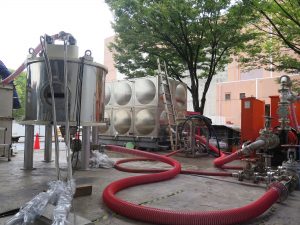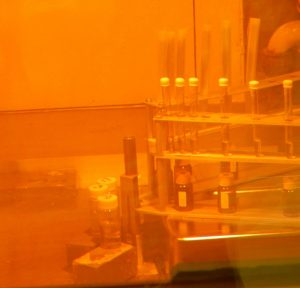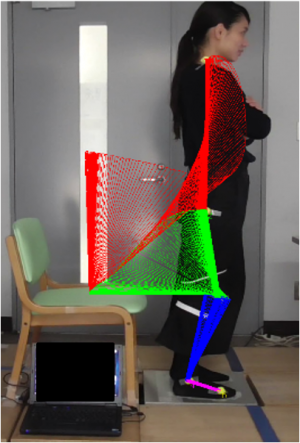Yoko AKIYAMA

Position: Associate Professor
Degree: Ph.D (Engineering)
Laboratory: Quantum Beam and Biomaterials Engineering
to Laboratory Homepage
Environmental purification / resource recycling / low-invasive treatment using magnetic force
 Using a strong magnet with a magnetic field 10 times that of a permanent magnet, we can attract the substances that are not usually attracted to magnets, float the substances in liquid, and control the movement of nanoparticles in the body. For example, cesium can be removed from the contaminated soil discharged following the Fukushima Daiichi Nuclear Power Plant incident, harmful substances in water can be removed, and variable materials can be extracted and recycled from waste, while the technology can also be applied for cancer treatment with low side effects. At present, we are studying the practical application of this technology.
Using a strong magnet with a magnetic field 10 times that of a permanent magnet, we can attract the substances that are not usually attracted to magnets, float the substances in liquid, and control the movement of nanoparticles in the body. For example, cesium can be removed from the contaminated soil discharged following the Fukushima Daiichi Nuclear Power Plant incident, harmful substances in water can be removed, and variable materials can be extracted and recycled from waste, while the technology can also be applied for cancer treatment with low side effects. At present, we are studying the practical application of this technology.
Changes in the material properties by irradiations
 It is vital that the materials used for medical devices that must be sterilized, and for airplanes, space vehicles, and the fusion reactors regarded as a new energy source, do not deteriorate when irradiated. At the same time, by utilizing the chemical reactions caused by irradiation, it is possible to create materials with new functions. In view of this, we are currently studying the development of radiation-resistant materials and new materials by examining the effects of irradiation, mainly in terms of organic polymers.
It is vital that the materials used for medical devices that must be sterilized, and for airplanes, space vehicles, and the fusion reactors regarded as a new energy source, do not deteriorate when irradiated. At the same time, by utilizing the chemical reactions caused by irradiation, it is possible to create materials with new functions. In view of this, we are currently studying the development of radiation-resistant materials and new materials by examining the effects of irradiation, mainly in terms of organic polymers.
Quantification of human sensations and physical functions
 The mechanism behind the tactile sensations expressed by words such as “moist,” “fresh,” and “stiff” is not yet fully understood. By elucidating this mechanism, it may be possible to measure tactile sensations using machines, transferring the sensations through a network, and furnishing robots with these tactile sensations. In addition, simple and objective assessments of the deterioration of athletic ability or posture distortion can help people to maintain their health throughout their lives. With this in mind, we are currently conducting research involving sensors and image analysis.
The mechanism behind the tactile sensations expressed by words such as “moist,” “fresh,” and “stiff” is not yet fully understood. By elucidating this mechanism, it may be possible to measure tactile sensations using machines, transferring the sensations through a network, and furnishing robots with these tactile sensations. In addition, simple and objective assessments of the deterioration of athletic ability or posture distortion can help people to maintain their health throughout their lives. With this in mind, we are currently conducting research involving sensors and image analysis.
Publication
- J. Yamamoto, T. Mori, Y. Akiyama, H. Okada, N. Hirota, H. Matsuura, S. Namba, T. Sekine, F. Mishima, S. Nishijima, “Removal of Iron Scale from Boiler Feed-water in Thermal Power Plant by Magnetic Separation – Large-scale Experiment-”, IEEE Transactions on Applied Superconductivity, Volume 29, No. 5, 0603705 (2019).
- M. Hiramatsu, J. Yamamoto, Y. Akiyama, F. Mishima, S. Nishijima, H. Okada, N. Hirota, T. Yamaji, H. Matsuura, S. Namba, “Removal of Scale from Feed-water in Thermal Power Plant by Magnetic Separation -Analysis of Oxygenated Treatment Scale-”, Journal of Physics: Conference Series, Volume 1293, Number 1,012079 (2019).
- J. Amosse,Y. Akiyama, “Remediation of Groundwater Contaminated by Heavy Metals Using Magnetic Separation Technique”, Journal of Physics: Conference Series, Volume 1293, Number 1, 012080 (2019).
- M. Kirimura, Y. Akiyama, “Fundamental Study on a Cancer Therapy by Blocking Newborn Blood Vessels Using a Rotating Magnetic Field”, Journal of Physics: Conference Series, Volume 1293, Number 1, 012082 (2019).
- S. Kito, Y. Akiyama, S. Nishijima, “Study on irradiation effect of insulating materials for fusion superconducting magnet: Change in electric insulation performance by irradiation”, IOP Conference Series: Materials Science and Engineering,Volume 502, 012195 (2019).
- Y. Ito, Y. Akiyama, “Study on separation of nonferrous metal utilizing magneto-Archimedes method”, Progress in Superconductivity and Cryogenics, Volume 21, pp. 10-14 (2019).
- C. Mukuta, Y. Akiyama, “Fundamental study on sustainable treatment system of mine water using magnetized solid catalyst”, Progress in Superconductivity and Cryogenics, Volume .21, pp. 15-21 (2019).